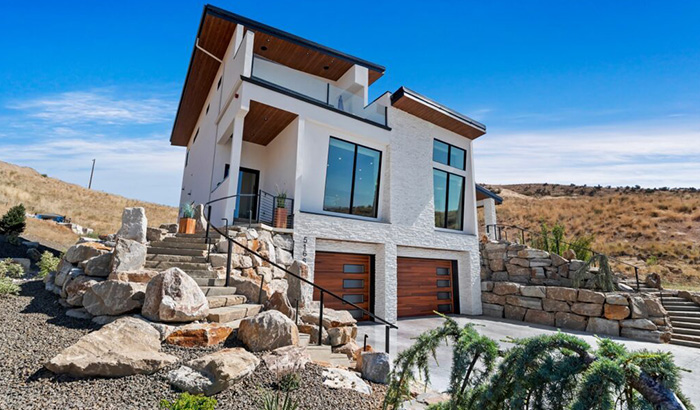
Eco-friendly windows stand as a pivotal solution for homeowners eager to embrace sustainability and energy efficiency in their living spaces. In an age where environmental responsibility and cost savings go hand in hand, the choice of windows in your home can make a substantial difference.
These advanced windows promise to reduce your carbon footprint and bring a new level of comfort and aesthetic refinement to your surroundings. Our comprehensive guide offers an in-depth look into how upgrading your windows could transform your home into a model of green living.
From decoding energy ratings to unveiling cutting-edge window technologies, this blog will guide you through the essential steps to a more sustainable and efficient home. Dive into the world of eco-friendly windows with us and discover how your home can become a haven of comfort and a testament to sustainable living.
The significance of eco-friendly windows
Eco-friendly windows hold immense significance in promoting energy efficiency and sustainability in our homes. These windows are specifically designed to help reduce energy consumption while providing a comfortable living environment.
One of the primary benefits of eco-friendly windows lies in their ability to conserve energy. Traditional windows often allow heat transfer, leading to increased energy usage for heating and cooling purposes.
However, eco-friendly windows are equipped with advanced technologies that minimize heat exchange through their efficient insulation properties. This insulation keeps the indoor temperature regulated and significantly reduces the need for artificial heating or cooling, resulting in lower energy bills.
Eco-friendly windows also play a crucial role in reducing greenhouse gas emissions. By minimizing the need for excessive heating and cooling, these windows help in decreasing the demand for fossil fuel consumption.
This subsequently results in a reduction in harmful greenhouse gas emissions, which contribute to global warming and climate change. Upgrading your home with eco-friendly windows showcases your commitment to a sustainable future and contributes to the preservation of our planet.
Understanding window energy ratings
Window energy ratings provide valuable information about a window’s energy performance. They help homeowners understand how well a window can insulate their home and prevent unwanted heat loss or gain. Let’s take a closer look at the different components of window energy ratings and what they mean for your home.
U-Factor
This rating measures the amount of heat transferred through a window. The lower the U-factor, the better a window’s insulation properties. In other words, a window with a low U-factor will keep your home warmer in the winter and cooler in the summer. Look for windows with U-values of 0.30 or lower for optimal energy efficiency.
Solar Heat Gain Coefficient (SHGC)
The SHGC measures the amount of solar radiation that penetrates a window and enters your home as heat. A lower SHGC means less heat gain from the sun. This is especially important if you live in a warm climate and want to keep your home cool during the hot summer months. Look for windows with SHGC values of 0.40 or lower for maximum energy efficiency.
Visible Transmittance (VT)
The VT rating measures the amount of visible light that passes through a window. A higher VT means more natural light entering your home, reducing the need for artificial lighting during the day. Look for windows with high VT ratings to maximize natural light and reduce your energy consumption.
Air Leakage (AL)
The AL rating measures the amount of air that infiltrates your home through the window. A lower AL value indicates a tighter seal and better insulation against drafts. Look for windows with AL ratings of 0.30 or lower to minimize air leakage and improve energy efficiency.
Condensation Resistance (CR)
The CR rating measures a window’s ability to resist condensation build-up. High CR ratings indicate that the window’s surface temperature remains closer to the indoor air temperature, reducing the likelihood of condensation forming. Look for windows with high CR ratings to minimize condensation and potential damage to your home.
Understanding these window energy ratings will help you make informed decisions when selecting windows for your home. However, keep in mind that energy efficiency is not the only factor to consider. Durability, maintenance requirements, and design options should also be taken into account to ensure the windows meet your overall needs.
To maximize energy efficiency, consider other features that could complement your windows, such as window films, shades, or curtains. These additions will further reduce heat gain or loss and improve the overall performance of your windows.
Additionally, proper installation is crucial for optimal energy efficiency. Even the most energy-efficient windows may not perform as expected if not installed correctly. Hiring a professional window installer or following the manufacturer’s instructions will help ensure a proper installation that maximizes energy efficiency and minimizes air leakage.
By understanding and considering window energy ratings, you can upgrade your home with eco-friendly windows that promote energy efficiency and sustainability.
Types of eco-friendly windows
Are you looking for ways to make your home more energy efficient and sustainable? One of the most effective ways to do so is by upgrading your windows to eco-friendly options. Let’s take a look at your options:
Double-pane windows
Double-pane windows, also known as insulated windows, are designed to provide better thermal insulation compared to traditional single-pane windows. These windows consist of two layers of glass with an insulating space between them, typically filled with air or a non-toxic gas like argon.
This insulating space prevents heat transfer, keeping your home cool in the summer and warm in the winter. Double-pane windows significantly reduce your energy consumption and help you lower your utility bills.
Low-E coating windows
Low-emissivity (Low-E) coating windows are designed to reduce the amount of infrared and ultraviolet (UV) light that enters your home. This special coating is applied to the glass surface, allowing visible light to pass through while blocking the harmful rays.
Besides protecting your furnishings from fading under UV exposure, Low-E coating windows also help maintain a comfortable indoor temperature by reflecting the sun’s heat during summer and retaining warmth during winter. By reducing the need for excessive air conditioning or heating, you’ll save energy and reduce your carbon footprint.
Triple-pane windows
Similar to double-pane windows, triple-pane windows have three layers of glass separated by insulating spaces. This additional layer adds an extra level of insulation and noise reduction, making them ideal for areas with extreme weather conditions or high noise pollution.
Triple-pane windows provide enhanced energy efficiency, minimizing heat loss or gain, and improving overall thermal performance.
Framing materials
Apart from the type of glass used, the framing materials of your windows also play a significant role in energy efficiency and sustainability. Traditional window frames made of aluminum are strong but thermally conductive, which leads to heat loss or gain.
Opting for eco-friendly framing materials like vinyl, wood, or fiberglass will help minimize energy transfer and enhance the insulation properties of your windows. Each material has its own advantages and considerations, so make sure to choose one that best suits your preferences and climate conditions.
Retrofitting vs. replacement
When it comes to upgrading your home for energy efficiency and sustainability, one of the most important areas to consider is your windows. Old, inefficient windows waste energy and drive up your utility bills, not to mention contribute to a less sustainable lifestyle.
But what is the best way to improve your windows?
Should you retrofit or replace them entirely?
Let’s explore the differences between these two options and find out which one is the right choice for you.
Retrofitting
Retrofitting your windows involves making modifications to your existing windows to make them more energy-efficient. This includes adding weatherstripping, caulking, or applying window films to reduce drafts and heat transfer.
Retrofitting is a cost-effective option, as it generally requires less material and labor than a full replacement. It is also less intrusive, as it does not involve removing the entire window frame.
One of the most common methods of retrofitting is the application of window films. These thin, transparent films are applied directly to the glass and are designed to reduce heat gain by reflecting sunlight. They also help minimize UV radiation and glare.
Window films come in various grades and shades, allowing you to customize the appearance and performance to meet your needs. They are relatively easy to install and can be a DIY project for those with some basic handy skills.
Another method of retrofitting is the installation of weatherstripping. Weatherstripping is a material that is applied to the edges of windows and doors to fill gaps and prevent air leakage.
It’s made of various materials such as foam, felt, or rubber, and comes in different forms such as adhesive strips, V-strips, or door sweeps. Weatherstripping is an effective way to reduce drafts and improve the energy efficiency of your windows without the need for a full replacement.
While retrofitting offers several benefits, there are some limitations to consider. Retrofitting measures may not achieve the same energy efficiency levels as a full replacement.
Old windows may have other issues besides inefficiency, such as warping, rotting, or broken frames, that cannot be addressed through retrofitting alone. If your windows are in poor condition or if you desire a significant upgrade in energy efficiency, a full window replacement may be the best option.
Replacement
Replacement windows involve removing the entire existing window unit and replacing it with a new, energy-efficient window. This option allows you to choose from a wide variety of styles, materials, and features that will enhance the energy efficiency and aesthetics of your home.
Replacement windows often have improved insulation properties, better noise reduction, and enhanced security features compared to older windows. They are designed to fit your home precisely and meet current energy efficiency standards.
However, full window replacement can be a more expensive and time-consuming option compared to retrofitting. It requires professional installation, and the process may involve removing interior trim or modifying surrounding walls.
Despite these considerations, replacement windows offer the most comprehensive and long-lasting solution for energy efficiency and sustainability in your home.
So, which option is right for you — retrofitting or replacement? The answer depends on various factors such as the current condition of your windows, your budget, and your goals for energy efficiency.
If your windows are still in good condition and only need some small improvements, retrofitting is a cost-effective choice. However, if your windows are outdated, inefficient, or damaged, a full replacement will provide the best long-term benefits.
When considering your options, it is also important to think beyond the windows themselves. Upgrading your home for energy efficiency and sustainability may involve other measures such as insulating walls, sealing air leaks, or adding shading devices. A holistic approach that addresses all aspects of your home’s energy use will yield the greatest results.
Upgrade your windows with Valley Glass
Ready to take the next step towards a greener, more energy-efficient home? Valley Glass is here to turn your aspirations into reality.
Whether you’re considering retrofitting your existing windows or investing in full replacements with the latest eco-friendly technologies, our team of experts is dedicated to providing you with top-notch solutions tailored to your needs.
At Valley Glass, we believe in the power of sustainable living and are committed to helping you enhance your home’s energy efficiency and aesthetic appeal. Don’t wait to make a positive impact on the environment and your energy bills. Contact Valley Glass today, and explore how our eco-friendly window options can transform your home.


Leave a Reply